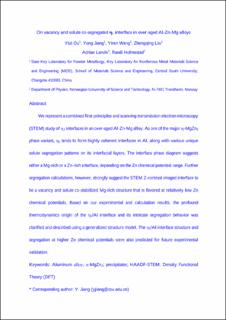| dc.contributor.author | Ou, Yizi | |
| dc.contributor.author | Jiang, Yong | |
| dc.contributor.author | Wang, Yiren | |
| dc.contributor.author | Liu, Zhengqing | |
| dc.contributor.author | Lervik, Adrian | |
| dc.contributor.author | Holmestad, Randi | |
| dc.date.accessioned | 2022-03-29T11:38:11Z | |
| dc.date.available | 2022-03-29T11:38:11Z | |
| dc.date.created | 2021-07-07T10:46:39Z | |
| dc.date.issued | 2021 | |
| dc.identifier.citation | Acta Materialia. 2021, 218 . | en_US |
| dc.identifier.issn | 1359-6454 | |
| dc.identifier.uri | https://hdl.handle.net/11250/2988337 | |
| dc.description.abstract | We present a combined first-principles and scanning transmission electron microscopy (STEM) study of the η1/Al interfaces in an over-aged Al-Zn-Mg alloy. As one of the major η-MgZn2 precipitate types, η1 tends to form highly coherent interfaces with Al matrix, along with various solute segregation patterns on its interfacial layers. The interface phase diagram suggests either an Mg-rich or a Zn-rich interface, depending on the chemical potential range of Zn. Further segregation calculations, however, strongly suggest the STEM Z-contrast imaged interface to be a vacancy and solute co-stabilized Mg-rich structure that is favored at relatively low Zn chemical potentials. Based on our experimental and calculation results, the profound thermodynamics origin of the η1/Al interface and its intricate segregation behavior is clarified and described using a generalized structure model. The η1/Al interface structure and segregation at higher Zn chemical potentials are also predicted for future experimental validation. | en_US |
| dc.language.iso | eng | en_US |
| dc.publisher | Elsevier | en_US |
| dc.relation.uri | https://www.sciencedirect.com/science/article/pii/S1359645421004626 | |
| dc.subject | Tetthetsfunksjonal teori | en_US |
| dc.subject | Density functional theory | en_US |
| dc.subject | Scanning transmisjonselektronmikroskopi | en_US |
| dc.subject | Scanning transmission electron microscopy | en_US |
| dc.subject | Aluminiumforbindelser | en_US |
| dc.subject | Aluminum Compounds | en_US |
| dc.title | Vacancy and solute co-segregated η1 interface in over-aged Al-Zn-Mg alloys | en_US |
| dc.type | Journal article | en_US |
| dc.type | Peer reviewed | en_US |
| dc.description.version | acceptedVersion | en_US |
| dc.rights.holder | This article will not be available until 1 October 2023 due to publisher embargo - © 2022. This manuscript version is made available under the CC-BY-NC-ND 4.0 license | en_US |
| dc.subject.nsi | VDP::Kondenserte fasers fysikk: 436 | en_US |
| dc.subject.nsi | VDP::Condensed matter physics: 436 | en_US |
| dc.source.pagenumber | 9 | en_US |
| dc.source.volume | 218 | en_US |
| dc.source.journal | Acta Materialia | en_US |
| dc.identifier.doi | 10.1016/j.actamat.2021.117082 | |
| dc.identifier.cristin | 1920631 | |
| dc.relation.project | Norges forskningsråd: 197405 | en_US |
| dc.relation.project | Norges forskningsråd: 247598 | en_US |
| cristin.ispublished | true | |
| cristin.fulltext | postprint | |
| cristin.qualitycode | 2 | |
